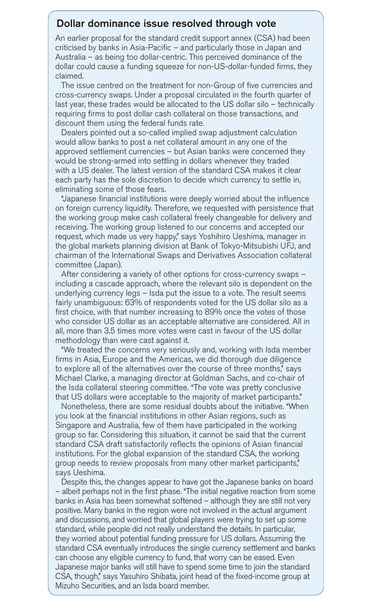
Cutting complexity with a new standard CSA
A new standard credit support annex will be launched within months and is meant to curtail disputes over the valuation of collateralised derivatives trades. But only a handful of firms are expected to adopt the document in its first phase. By Nick Sawyer

 The architects of the original credit support annex (CSA) may well have congratulated themselves on a job well done. By drawing up a document governing the exchange of collateral between two derivatives counterparties, they might have felt they had made a big contribution to the safety and soundness of the over-the-counter derivatives market. Unknowingly, however, they also introduced an incredible amount of complexity. By building a number of options into the agreement, they unwittingly ensured that virtually every CSA is unique – a fact tvhat has led to valuation discrepancies on even the most plain vanilla interest rate swaps.
The architects of the original credit support annex (CSA) may well have congratulated themselves on a job well done. By drawing up a document governing the exchange of collateral between two derivatives counterparties, they might have felt they had made a big contribution to the safety and soundness of the over-the-counter derivatives market. Unknowingly, however, they also introduced an incredible amount of complexity. By building a number of options into the agreement, they unwittingly ensured that virtually every CSA is unique – a fact tvhat has led to valuation discrepancies on even the most plain vanilla interest rate swaps.
This has elicited complaints from end-users about a
lack of transparency and an inability to compare prices between dealers. More problematic, it has meant novations between counterparties have almost ground to a halt, as has the back-loading of trades to central counterparties (CCPs) – contributing to a reduction in market liquidity, participants say.
“You need to be confident you can unwind or novate a transaction easily, without getting into a disagreement with the other counterparty over the price. The capacity to novate quickly has become more difficult, and this has affected liquidity,” says Thibaut de Roux, head of global markets for Europe, the Middle East and Africa at HSBC in Paris.
“There is reduced liquidity, and issues on the relationship side. There is no real consistency, and clients have been getting more upset with it,” adds Juergen Feil, a managing director in rates exotic trading at Deutsche Bank in London.
Help could be at hand, though. Led by the International Swaps and Derivatives Association, dealers have been working for the best part of two years to draw up a new standard CSA that aims to eliminate the sources of valuation disputes and bring industry practice more in line with London-based clearing house LCH.Clearnet. The template is more or less agreed, and the first adopters – most likely a handful of big US and European dealers – could be using the new document within months.
Aligning the core variation margin structure across cleared and bilateral hemispheres of the market makes risk management sense
Reasons for concern
Not everyone is won over, however. There have been complaints the document is too complex, particularly in its proposed approach for calculating a net settlement currency. Some banks have also expressed concern about the perceived dollar dominance of the document – although these fears were largely addressed earlier this year (see box, Dollar dominance issue resolved through vote). Another source of unease is the changes to systems and processes that will be required, especially because banks will likely have to run two systems in parallel – one for legacy trades under the existing collateral agreement and one for new business under the standard CSA. Taken together, it could slow the take-up of the new document, at least in the initial phase.
“I think we will take a wait-and-see approach,” says Tong Lee, global head of rates at UniCredit in London. “We will need to look very closely and see what the impact will be.”
There may be disagreements over certain aspects of the standard CSA, but most dealers recognise the current situation has led to big problems. The difficulty stems from the huge amount of optionality embedded in the existing document. Each set of counterparties can agree on a list of eligible collateral they will post to each other, as well as the threshold at which they will start to post, the minimum transfer amount, and any additional triggers or termination events. This means virtually no two CSAs are identical: one CSA might restrict the two parties to posting dollars with a zero threshold, while another might allow the counterparties to choose between dollars, euros, US Treasury bonds and even equities with a $50 million threshold.
This has only become an issue relatively recently. Banks used to discount everything at Libor, even though many realised the overnight indexed swap (OIS) curve should theoretically be used as a discount rate for cash-collateralised trades, as this determines the interest rate paid on cash collateral. During the financial crisis, however, the basis between Libor and OIS blew out massively – making it clear that Libor couldn’t be relied upon as an easy, one-stop-shop discount rate. As a result, the large dealers started to move to OIS discounting, with the relevant rate determined by the currency of the collateral being posted – so a swap collateralised with dollar cash would be discounted using the federal funds rate, regardless of the underlying currency of the trade (Risk March 2010, pages 18–22).
This becomes hugely complex when counterparties can choose from a list of eligible collateral, though – particularly when that list includes securities as well as cash. While OIS discounting is now generally accepted for cash collateral, there is much less consensus on what the correct discount rate should be when bonds are posted. Some argue the repo rate should theoretically be used, as this is the rate at which those assets can be funded. But repo markets are very short term, meaning an alternative has to be found – and many opt for Libor.
Once the correct discount curves have been determined for each of the eligible collateral types, dealers need to work out which one should be used to calculate the net present value (NPV) of each trade under that CSA. Most dealers agree the correct discount curve should be based on the cheapest-to-deliver collateral, on the assumption that counterparties will always look to post whatever asset is cheapest for them. However, what is cheapest now may not be cheapest in the future, meaning dealers need to look at the discount curves for each of the eligible collateral types, swap them into a single currency for comparison and consider what the cheapest collateral is at each point in time. The final theoretical step is to consider how this could change as market conditions alter.
Banks are taking a variety of approaches to this – some are looking at what is cheapest now and using a single discount rate for the entire duration of the trade, while others are constructing blended discount curves that try to reflect the cheapest-to-deliver collateral at any point in time (Risk March 2011, pages 18–23). As a result, each counterparty can end up with different valuations for the same transaction, which can contribute to disputes.
Crucially, any change in collateral terms will also have an economic implication for each counterparty – the main reason for novations slowing, say dealers. To take a simple example, a dollar-denominated swap backed by a CSA that allows the counterparties to deliver euro cash only should be discounted using the euro overnight index average (Eonia). If another dealer steps in via a novation, and has an existing CSA in place with the remaining counterparty that allows the posting of dollar cash only, that transaction would now be discounted at the federal funds rate – a change that can significantly alter the NPV of the trade. If the impact is large enough, the party that stands to lose out is likely to decline the request for novation. The same dynamics exist with the back-loading of trades to CCPs.
The standard CSA should eliminate many of the problems by removing the optionality. Instead, every trade will be allocated to one of 17 silos, based on the currency of the underlying trade. Counterparties will only be allowed to post cash collateral in that currency, and the trades in each silo will be discounted using the relevant OIS rate or – if a liquid OIS market doesn’t exist – an agreed alternative. So, for example, dollar-denominated trades would be allocated to the dollar bucket, the counterparties would be required to post dollar cash collateral, and the federal funds rate would be used to discount those trades.

Only users who have a paid subscription or are part of a corporate subscription are able to print or copy content.
To access these options, along with all other subscription benefits, please contact info@risk.net or view our subscription options here: http://subscriptions.risk.net/subscribe
You are currently unable to print this content. Please contact info@risk.net to find out more.
You are currently unable to copy this content. Please contact info@risk.net to find out more.
Copyright Infopro Digital Limited. All rights reserved.
As outlined in our terms and conditions, https://www.infopro-digital.com/terms-and-conditions/subscriptions/ (point 2.4), printing is limited to a single copy.
If you would like to purchase additional rights please email info@risk.net
Copyright Infopro Digital Limited. All rights reserved.
You may share this content using our article tools. As outlined in our terms and conditions, https://www.infopro-digital.com/terms-and-conditions/subscriptions/ (clause 2.4), an Authorised User may only make one copy of the materials for their own personal use. You must also comply with the restrictions in clause 2.5.
If you would like to purchase additional rights please email info@risk.net
More on Interest rate markets
New benchmark to give Philippine peso swaps a fillip, post-Isda add
Isda to include new PHP overnight rate and Indonesia’s Indonia in its next definitions update
SABR convexity adjustment for an arithmetic average RFR swap
A model-independent convexity adjustment for interest rate swaps is introduced
NatWest Securities US Treasury trading head departs
Jason Sable joined the UK bank in January 2022 from BNP Paribas
CME in talks to clear term SOFR basis swaps
US clearing house has held discussions with some dealers about clearing term SOFR-SOFR packages
Risky caplet pricing with backward-looking rates
The Hull-White model for short rates is extended to include compounded rates and credit risk
The curious case of backward short rates
A discretisation approach for both backward- and forward-looking interest rate derivatives is proposed
Cross-currency swaps will use RFRs on both legs, says JP exec
Despite slow start, all-RFR swaps will become the market standard within a year, according to Tom Prickett
June mid-month auctions – Coupon and yield trends
As Treasury issuance amounts set new records, coupons at the front end of the curve have marched downward, while back-end coupons have lagged. Yield spreads across each popular measure show a consistent steepening of the curve through the first half of…







